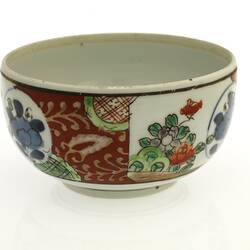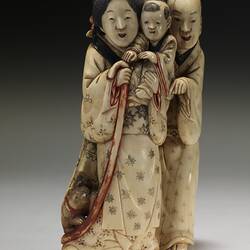Summary
Imari-style bowl with floral design, manufactured in Japan, probably during the early Meiji Period (1868-1880).
Imari porcelain ware takes it name from the port-city of Imari in the Saga Prefecture on the southern island of Kyushu, Japan. From the late 17th century, Imari porcelain was extensively exported specifically for the European market. In Japan, this type of porcelain is also referred to as Arita-yaki, as much of it is made in the town of Arita in the Saga Prefecture.
The Japanese firm Koransha exhibited Imari ware at the 1880 Melbourne International Exhibition. The Koransha Factories were established at Arita in 1875 by Eizaemon Fukagawa, of the well-established Fukagawa family of ceramists, for the purpose of producing porcelain ware for the Western export market. The company subsequently won a certificate of merit at the Philadelphia Centennial Exposition in 1876, and a gold prize at the 1878 Paris Universelle Exposition. They exhibited Arita porcelain bowls, flower-vases - such as this one - and tea sets in Melbourne in 1880.
Physical Description
Small bowl, blue-white glaze, painted with red, blue, orange and green flowers. No markings.
More Information
-
Collection Names
-
Collecting Areas
-
Acquisition Information
Cultural Gifts Donation from Dr Will Twycross, 23 Jan 2009
-
Acknowledgement
Donated through the Australian Government's Cultural Gifts Program
-
Place & Date Made
-
Place & Date Exhibited
Royal Exhibition Building (REB), Melbourne, Greater Melbourne, Victoria, Australia, 1880-1881
-
Collector
Mr John Twycross, Elsternwick, Greater Melbourne, Victoria, Australia, 1880-1881
-
Classification
Royal exhibition building, International exhibitions, Exhibition heritage
-
Category
-
Discipline
-
Type of item
-
Overall Dimensions
107 mm (Width), 60 mm (Height)
-
Maximum dimensions
61 mm (Height), 108 mm (Outside Diameter)
Measurement From Conservation.
-
Keywords
Ceramics, Decorative Arts, Exhibitions: Melbourne International, 1880-1881, Japanese Art, Royal Exhibition Building



